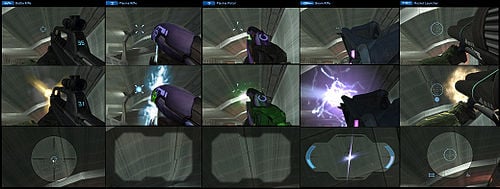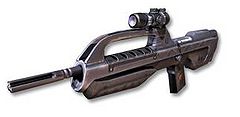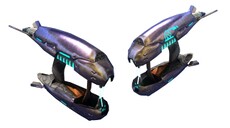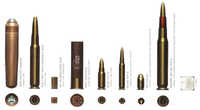Weapons (gameplay)
From Halopedia, the Halo wiki
- For the full list of weapons see Category:Weapons
The weapons from the Halo Universe, available in Campaign and Multiplayer gameplay, form the basis of First Person Shooter Gameplay within the Halo games.
Origin
The player is allowed to use weapons from many races, such as Humans, Covenant, and Forerunner, often turning the enemy's firepower against them.
Human weapons tend to use bullets, explosives, rail guns, and lasers. Covenant weapons are generally plasma or energy based, with the exception of Brute weapons, which use spikes or explosives. All plasma weapons use charge. All weapons run out of ammunition or charge when used extensively. Covenant weapons typically overheat if fired continuously for long periods of time, which causes your weapon to be unresponsive.
To know more about the weapons from each set of races:
| UNSC Weaponry | Covenant Weaponry | Forerunner Weaponry |
|---|---|---|
A UNSC Battle Rifle. |
Two Covenant Plasma Rifles. |
Error: Image is invalid or non-existent. |
Gameplay
An extensive array of weapons are available within the gameplay, with each weapon operating differently. This allows players to take different approaches and sometimes forces a change in tactics depending on the strengths and weaknesses of each weapon. Each player will also find a weapon to suit his or her tastes, in terms of power, speed, range, kickback and/or feedback.
Usage
Halo: Combat Evolved limited the number of weapons players could carry to two (Except for a glitch in the Halo: Combat Evolved Campaign level "The Pillar of Autumn") (of which only one could be used at any one time), forcing players to carefully select their preferred armament.[1] Players fight with ranged and melee attacks, as well as a limited number of grenades. Bungie refers to the "weapons-grenades-melee" format as the "Golden Triangle of Halo",[2] which has remained fundamentally unchanged throughout the trilogy. The player character's health is measured in both hit points and a continually recharging energy shield.[3] The energy shield absorbs a significant portion of enemy fire until it becomes depleted, after which the player character will sustain damage, potentially causing death.
Halo 2 introduced new gameplay elements, most notably the ability to hold and fire two weapons simultaneously, known as "dual wielding". The health system was altered in this game, with the player no longer having hit points as well as shields. The Assault Rifle was not included in this game.[4]
Halo 3 adds to the series new weapons, and a class of items called Equipment. The Assault Rifle returns in this incarnation, albeit with a decreased magazine capacity, but with more damage per hit.[5]
Halo 3: ODST adds stealthier weapons, namely the Silenced SMG and the Suppressed Auto Mag. Hit points returned in this game. Also, the game does not contain the Battle Rifle, Equipment, or dual wielding. Halo 3: ODST also marks the return of the Brute Plasma Rifle, replacing the regular version.[6].
Aiming

The typical arrow cursor is hidden within gameplay, and replaced with a blue targeting reticule that stays locked to the center of the screen, when in first person and third person views. The reticule turns red when a shot will hit an enemy target, and green for allies.
Many weapons are scoped and have the capability to zoom 2x or 5x into any area, with some long range weapons even capable of reaching up to 10x magnification such as the Sniper Rifle. These always show the reticule and continue scoping after shots are fired.
While wielding non-scoped weapons, the player's armor has the capability to zoom, to a minimal extent. These hide the reticule when in the zoomed view, returning to the normal view after every shot, making them inefficient for sniping. However, skilled players can use this in online gameplay to keep a good eye on enemies or destinations.
Types
The types of available weapons follow the basic standards present in real life, Assault, Battle and Sniping.
Grenades are frequently made available, primarily for anti-infantry combat. Some grenades can stick and some grenades are stronger than others.
Melee attacks are always available; if the player is able to get in range of an enemy, that can cause heavy damage. And melee attacks are very dangerous when you hit an enemy in the back, this will kill almost any enemy. Most times, a single melee attack is sufficient to completely deplete an enemy's shields. These are also used to take control of an enemy Vehicle, by Melee attacking the craft, then planting a grenade to kill its driver.
Heavy weapons, such as Turrets, are also present within Halo levels, either stationary, or mounted on Vehicles. Some turrets can be removed from their stands and used as hand held Support Weapons, but it makes the player move slower. Only when driving a vehicle, controlling a Missile pod, controlling the Flamethrower, and controlling a turret, does the game switch into third-person view. Some vehicles, such as the Ghost, Scorpion Tank, and Banshee allow the driver to directly control mounted weapons while driving the vehicle. Other multi-occupant vehicles such as the Warthog require the player to remain in the weapon seat to control fire, and driving seat to control navigation.
Explosives and large scale weapons, Missiles, Nuclear, and Halos are usually involved in the storyline of every game, though not usually playable.
Availability

Within campaign levels, the player's character (Master Chief or The Arbiter) usually begins with two weapons, and will always have access to weapons lying around, either near corpses or within weapon caches and stores.
Killed enemies or allies can be robbed of their dropped weapons as well. In Halo 2 and onwards, the player can exchange weapons with allied AI when requested, making it unnecessary to kill them only to use their weapons and/or grenades.
Weapons can be reloaded by collecting ammunition or swapping the player character's weapon with a loaded dropped weapon. If the player is already wielding the same weapon, they can swap if the new weapon is loaded or charged more than the wielded weapon.
Common Tips
- Shooting a players' weapon will cause them to take damage, and even kill them. You can also stick them with a grenade on their weapon.
- A good trick to find snipers is to watch for the Vapor Trail left behind the enemies shot.
- A trick to kill enemy campers is to watch for their gun barrels sticking out from behind walls, barriers, etc.
- Simply running towards your enemy and shooting at the same time is not a good tactic. Try strafing too.
- Try shooting the head, not the body when using headshot capable weapons.
Gallery
Sources
- ^ Template:Cite web
- ^ Bakken, Lars, et al. Is Quisnam Protero Damno!, Bungie, Washington 2007
- ^ Template:Cite web
- ^ Template:Cite web
- ^ Template:Cite web
- ^ Bungie.net, ordnance, stealthy weapons of Halo 3:ODST
External Links
- How to Snipe in Halo 2 is a wikiHow guide that describes strategies for sniping in Campaign and especially Multiplayer.




